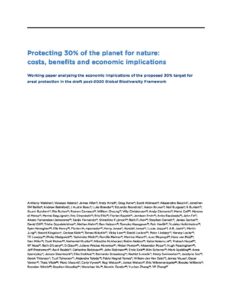Protecting 30% of the planet for nature: costs, benefits and economic implications

Author:
Anthony Waldron; Vanessa Adams; James Allan; Andy Arnell; Greg Asner; Scott Atkinson; Alessandro Baccini; Jonathan EM Baillie; Andrew Balmford; J Austin Beau; Luke Brander; Eduardo Brondizio; Aaron Bruner; Neil Burgess; K Burkart; and others
Publication Year:
2020
Citation:
Waldron, Anthony, Vanessa Adams, James Allan, Andy Arnell, Greg Asner, Scott Atkinson, Alessandro Baccini et al. "Protecting 30% of the planet for nature: costs, benefits and economic implications." (2020).
Description:
The World Economic Forum (WEF) and Intergovernmental Science-Policy Platform on Biodiversity and Ecosystem Services (IPBES) have both identified biodiversity loss as one of the main threats to global economic prosperity. In particular, this high-level warning specifies that any further loss of natural habitats and biodiversity will cause extensive and costly flooding, climate change, disease emergence and ill health, clean water shortages, loss of crop pollination, decline in productivity, and numerous other risks. All of these negative outcomes are the consequence of degrading the natural infrastructure that supports human economic activity and wellbeing. One of the main policy instruments to slow the loss of biodiversity and the degradation of nature is the creation of protected or conservation areas (simple examples being a Nature Reserve or Marine Reserve). Currently, ~16% of the land and 7.4% of the ocean is in areas designated or proposed for protection (although only 2.5% of the ocean is in highly/fully protected areas). This level of protection is widely acknowledged as being inadequate to achieve biodiversity protection goals. One of the headline proposals for the 15th meeting of the Conference of Parties to the CBD, and Action Target 2 of the draft post-2020 Global Biodiversity Framework, is to increase the area covered by protected areas (PAs) and other effective area-based conservation measures (OECMs) to 30% of the planet by 2030, including both land and water protection.
See related content:
- Explore the site by related topics: Biodiversity, Habitat and Biodiversity Loss, Marine Protected Areas
